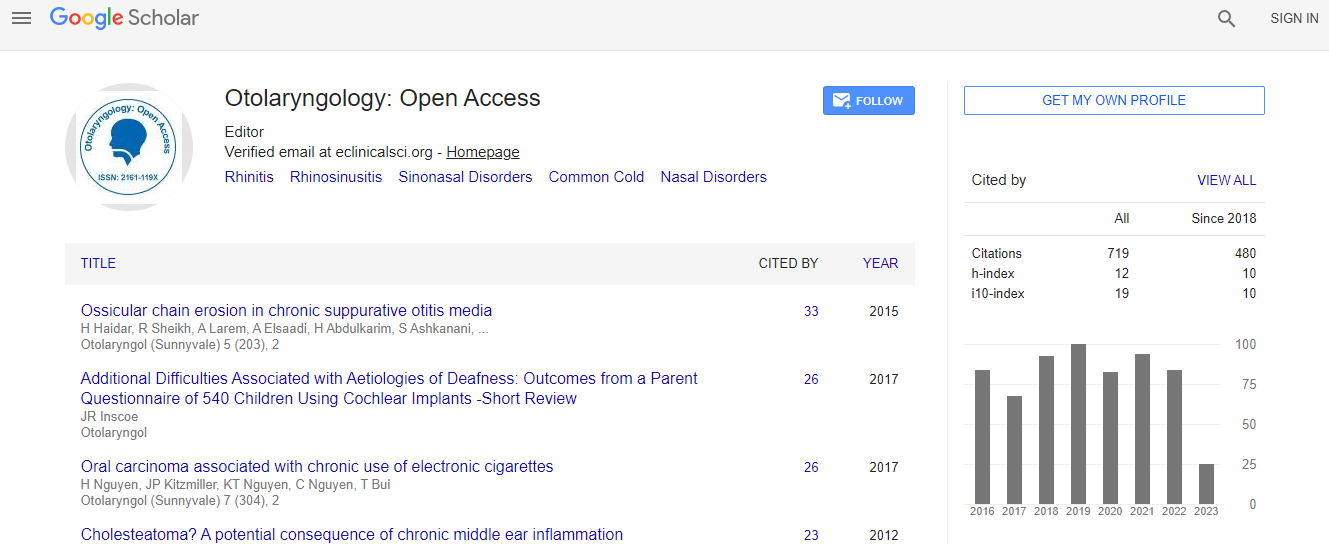Our Group organises 3000+ Global Conferenceseries Events every year across USA, Europe & Asia with support from 1000 more scientific Societies and Publishes 700+ Open Access Journals which contains over 50000 eminent personalities, reputed scientists as editorial board members.
Open Access Journals gaining more Readers and Citations
700 Journals and 15,000,000 Readers Each Journal is getting 25,000+ Readers
Google Scholar citation report
Citations : 925
Otolaryngology: Open Access received 925 citations as per Google Scholar report
Otolaryngology: Open Access peer review process verified at publons
Indexed In
- Index Copernicus
- Google Scholar
- Sherpa Romeo
- Open J Gate
- Genamics JournalSeek
- RefSeek
- Hamdard University
- EBSCO A-Z
- OCLC- WorldCat
- Publons
- Geneva Foundation for Medical Education and Research
- ICMJE
Useful Links
Recommended Journals
Related Subjects
Share This Page
Nasal unit transplantation: A cadaveric anatomical feasibility study
5th Global Summit and Expo on Head, Neck and Plastic Surgery
Amir H Dorafshar, Gerhard S Mundinger, Brent Robinson, Sami Tuffaha, Gerald Brandacher, Patrick Byrne and Robert L Walton
Johns Hopkins Hospital, USA Saint Joseph Hospital, USA
Posters & Accepted Abstracts: Otolaryngol (Sunnyvale)
Abstract
Background: The science and technical acumen in the field of vascularized composite allotransplantation (VCA) has progressed rapidly over the last 15 years and transplantation of specialized units of the face, such as the nose, appears possible. No study to date has evaluated the technical feasibility of isolated nasal unit transplantation (NUT). In this study, we explore the anatomy and technical specifics of nasal unit transplantation. Methods: 4 fresh cadaver heads were studied. Bilateral vascular pedicle dissections were performed in each cadaver. The facial artery was cannulated and injected with food dye under physiologic pressure in 2 cadavers and with lead oxide mixture 2 cadavers to evaluate perfusion territories supplied by each vascular pedicle. Results: The facial artery and vein were found to be adequate pedicles for NUT transplantation. Divergent courses of the vein and artery were consistently identified, which made for a bulky pedicle with necessary inclusion of large amounts of subcutaneous tissue. In all cases, the artery remained superficial, while the vein coursed in a deeper plane and demonstrated consistent anastomoses with the superior transverse orbital arcade. While zinc oxide injection of the facial artery demonstrated filling of the nasal vasculature across the midline, dye perfusion studies suggested that unilateral arterial inflow may be insufficient to perfuse contralateral NUT components. Discrepancies in these two studies underscore the limitations of nondynamic assessment of nutritive perfusion. Conclusion: NUT based on the facial artery and facial vein is technically feasible. Angiosome evaluation suggests that bilateral pedicle anastomoses may be required to ensure optimal perfusion.Biography
Email: adorafs1@jhmi.edu

 Spanish
Spanish  Chinese
Chinese  Russian
Russian  German
German  French
French  Japanese
Japanese  Portuguese
Portuguese  Hindi
Hindi 
